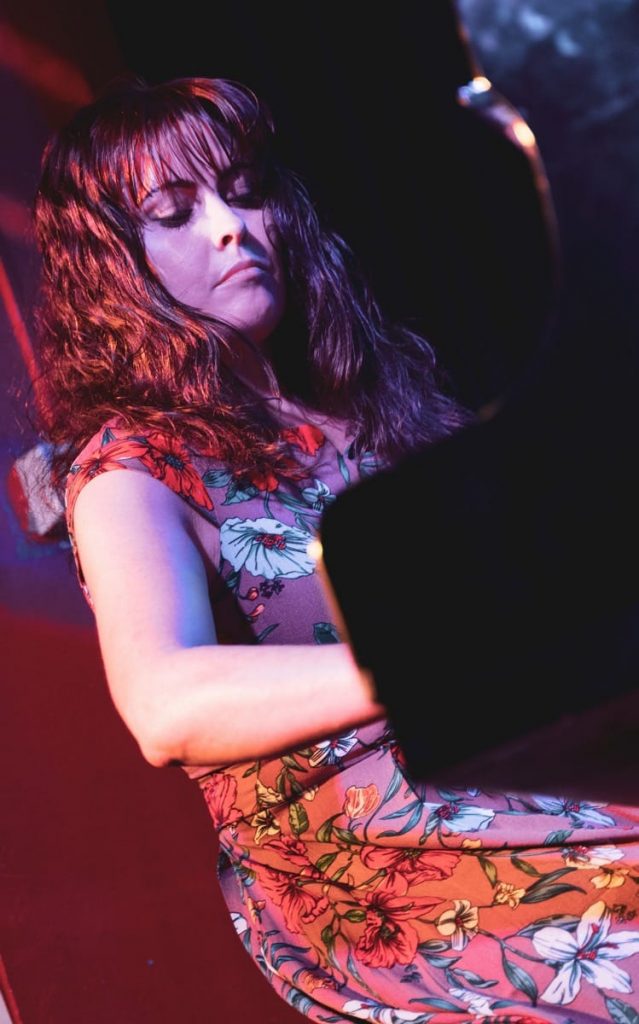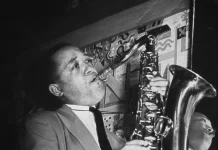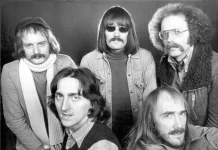
There are historical parallels between jazz and photography – both were nascent (primitive, if you like) in the second half of the 19th century. That famous photograph of Buddy Bolden, with his six-piece band, is believed to have been taken in 1890. The photo, partly out of focus, is redolent of things coming into being, both music and image. A century later both had developed, if you’ll pardon the pun, into sophisticated modes of communication.
Jazz had a comprehensive pictorial history by 1955 with the publication of A Pictorial History Of Jazz: People And Places From New Orleans To Modern Jazz by William Grauer Jr and Orrin Keepnews. Many of the pictures were the copyright of record companies, such as Atlantic, Blue Note, Riverside and Verve; libraries, including the Herman Rosenberg Collection; individual musicians, among them Tony Parenti, George Wettling, and Turk Murphy; and writers and producers, such as Leonard Feather and George Avakian. A Pictorial History went into further editions, the 1966 one after Bill Grauer’s death leading Keepnews to thank updating photographic lenders such as Steve Schapiro, Chuck Stewart, and Jack Bradley. From them, the pictures kept coming. My copy of the 1966 edition is on permanent loan, but I recall Keepnews in his acknowledgements thanking the aforesaid record companies for allowing a virtual looting of their picture libraries.
The final paragraph of the 1955 edition said there could be no summing-up of jazz at that point, “for which one should be thankful … it would have to mean that jazz was complete; or, in other words, dead.” I also recall that the final photograph in the 1966 edition was of Ornette Coleman. A Pictorial History, in spanning an evolution from the primitive to the quaint and sophisticated, never slipped into cynicism about what was happening to the music. It was balanced and well judged. Keepnews typically warned listeners not to regard Roland Kirk as a trickster but as a musician whose apparent gimmickry was really dedication.
I may be wrong, but I don’t think there were any more revised editions of the book. Other photo books came along, notably John Fordham’s Jazz, published in 1993 by Dorling Kindersley, a company which shook up the splicing of text and pictures and created a thing of beauty so that the reader didn’t have to chase words and their meanings into far-flung corners while appreciating the images. Ken Vail’s Jazz Milestones, “a pictorial chronicle” from 1800 to 1990, was another, its pictures sometimes harried into corners by blizzards of data. The well-known photographs taken by Herman Leonard, Francis Wolff (of Blue Note), William Claxton, Paul Hoeffer, Val Wilmer and others might be contrasted with rarities. Many of these are appearing on a Facebook page called Rare Jazz Photographs. The pictures are mostly black and white, a medium not inferior to colour but these days connoting historic status.
Two of the latest were of Charlie Parker, the first a superb colour restoration by Rob Di Maso of a monochrome by Esther Bubley. Parker sits forlornly on his sax case, looking not so much smart casual as wrecked casual. What a tragic figure he cut for someone so young. A post by Mark Patterson sums it up: “When I was a kid I thought Bird’s time (including this photo, in black-and-white) was ancient history. Now I realize it wasn’t that long ago at all. In a way this version, in comparison to the original, underscores that.” Nice one, Mark: colour brings everything closer. The second is a paparazzi shot of Parker, stoned to a tad short of lapidary and being lugged out of a subterranean club by Max Roach (allegedly) and Dean Benedetti, a musician more famous for the amateur recordings he made of Bird. As is the way with Facebook, most comments are more keen to establish their credentials – here in identifying the Roach character as Diz, and vice versa – than in pointing to how pathetic Parker looks and what the picture says about overblown aspects of the jazz life.
Other Facebook pages to look out for are Jazz Enthusiasts, Jazz North (notable for its supportiveness), Jazz Music, All About Jazz (for beginners and those who think they know everything but don’t), Jazz Heritage Wales (“Treftadaeth Jazz Cymru”), Jazz & Blues Experience, Jazz From Scotland and Jazz NI (Ulster). But there are loads of them worldwide, especially active in our pandemical torpor and eager to manufacture online playing opportunities.

Parker’s ambition to rank among “serious” musicians is well known. California became a different place for him once he discovered that Igor Stravinsky and Arnold Schoenberg lived there. As his biographer, Ross Russell, pointed out, Parker wanted stability, good health, and access to the music of that pair and to Hindemith, Varèse, Alban Berg and their ilk. If his music wasn’t exactly in their province as a style, he knew its pretensions to their serious gravity were valid. He planned to compose like them. No-one knew what that meant, not even Bird himself. Maybe his recordings with strings are pointers, even if they are disparaged by some.
This swirling region between genres, tempting for jazz musicians and “classical” ones, is becoming popular. I have recently covered whole-album jazz-inflected homages to Verdi, Debussy and Schubert. The latest I’ve reviewed takes a jazz view of J. S. Bach. It’s by the Australian pianist Keyna Wilkins, who spent her childhood in Somerset. She has taken a few of his miniatures and exposed them to Bill Evans’s “Amen” chord at the beginning of Miles Davis’s So What. The results are absorbing, in that the trick is to discover where the chord – three perfect fourths followed by a major third – makes itself felt.
Back to pictures. My new Alexa remote-control zapper is finding me lots of jazz on YouTube, the plenitude of which I wrote about in a past print version of JJ. She/it located a gig in Sweden by a Stan Getz Quartet (the excellent Jim McNeely on piano, bassist George Mraz, and drummer Victor Lewis), with Chet Baker as guest. I recall that a photo of Baker concluded the first edition of A Pictorial History Of Jazz. He was a 26-year-old James Dean lookalike then, offering as memorable an image as the one taken late in his life, in which he resembles a troubled Shar-Pei, the Chinese hound with rippled skin. Some of the rare photos in Rare Jazz Photographs are more irresistible than scarce.














